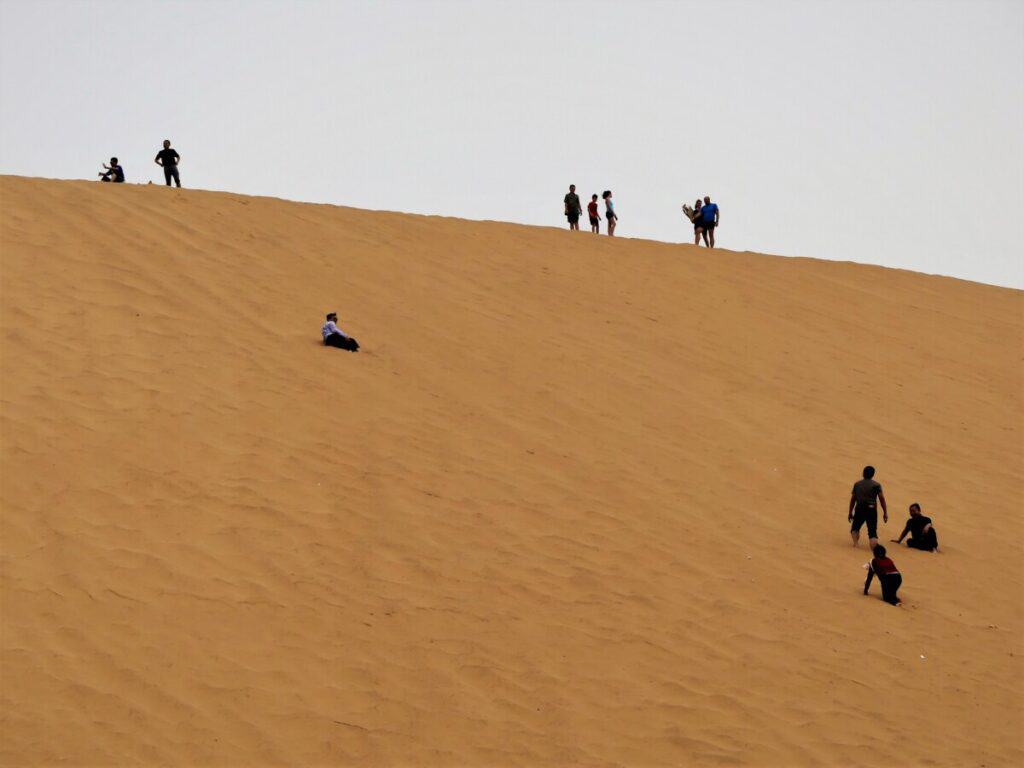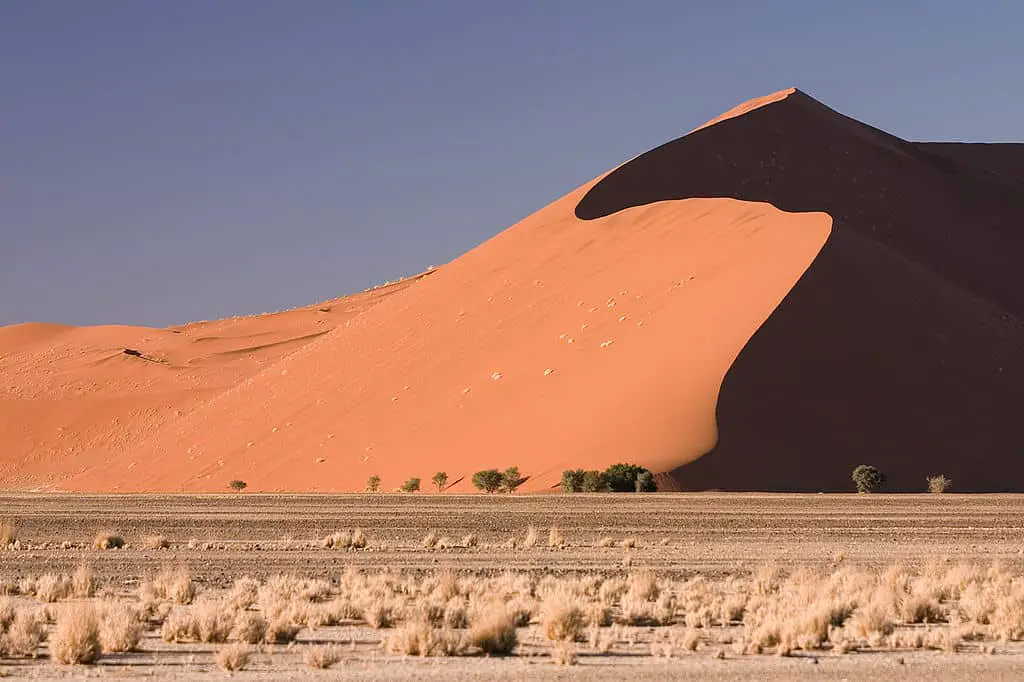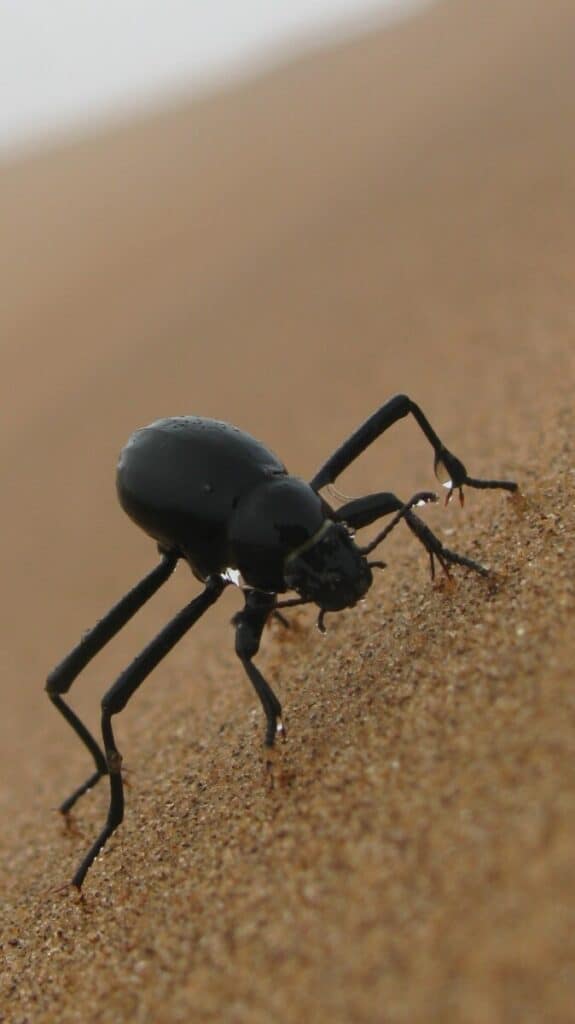On a couple of world cruises, we’ve stopped at Walvis Bay in Namibia. This is one of the best locations in the world to access giant sand dunes and to have the thrill of climbing them.
Two giant sand dunes that visitors can climb are Dune 7 and Dune 45. Dune 7, the highest in Namibia at 1,256 feet (383 m), is twenty minutes drive from the port city of Walvis Bay. Dune 45 is not as high at 280 feet (85 m) but even more spectacular, taking about four and a half hours by car.
Location of the Namib Sand Sea
To provide you with a better idea of the location, I’ve prepared a short 2 minute video fly-over of the desert and nearby town of Walvis Bay using Google Earth Pro. The dunes can be immense… 300 m high x 32 km long (980′ high X 20 mi long) and starkly beautiful and other-worldly in appearance! The dunes extend right into the sea, south of Walvis Bay. This town of approximately 60,000 is about the only natural deep water port for large cruise ships along the coast of Namibia.
The Namib Sand Sea is listed as a UNESCO World Heritage Site.
How to Access the Giant Dunes
One of the most spectacular and accessible dunes is Dune 45. It is, however, a relatively long four and a half hour drive from Walvis Bay, so if you are visiting on a cruise ship a better and much closer option would be Dune 7.
Dune 7 is easily accessible from Walvis Bay
Dune 7 is on the outskirts of Walvis Bay, and can be reached by taking a local tour or even a taxi – it’s only 20 minutes from town. I took the ship’s shore excursion and it was busy when we arrived at the parking lot.
Dozens of people were climbing to the top of the dune and some were sliding down or descending with giant steps or just thrashing crazily in the red sand. It was obviously an exciting place to visit, especially with kids.

Dune 7 is the highest dune in Namibia, at 1,256 feet (383 meters). Apparently it is named Dune 7 because it is the seventh dune after crossing the river Tsauchab.
Dune 45 is in a spectacular setting
One of the most amazing experiences in Namibia is to climb Dune 45 early in the morning to view sunrise from the top. This dune is 85 meters (280 ft) high and offers a panoramic view of the stunning valley below. Some people say that the sight from the top during evening can be other worldly with the valley bottom below looking like a “moonscape”.
Here’s a satellite view of Dune 45 from Google Maps — try sliding it around for some idea of the fascinating geography and scenery of the dunes of the Namib Sand Sea at Sossusvlei, Namibia.

Fascinating Facts about the Namib Sand Sea

The photo above was taken by an astronaut aboard the International Space Station (ISS) using a long lens. Astronauts consider this to be one of the most spectacular features of our planet. Imagine being able to lean up against a window offering a constant stream of such spectacular views!
The Namib is an ancient desert
The Namib Desert is one of the oldest deserts in the world with estimates of 55 million years. The sand itself is 5 million years old and colored a dramatic red from iron-rich deposits.
This place is a photographer’s dream as the lighting changes throughout the day and night, causing shadows and colors to constantly shift. The dunes in Sossusvlei are categorized as “star dunes,” because the wind blows from three directions, causing the sand to form star shapes. This also means that the dunes tend to remain anchored to one spot rather than drifting with the prevailing wind.
Coastal fog enriches life
Life in this desert is highly adapted to the cool coastal fog that sweeps over the dunes for over 100 days a year. The essential moisture and cooling influence of the fog makes it possible for life to abound in this seemingly desolate environment.
Namib Desert Beetle captures fog
One of the better known species that lives here is the fascinating Namib desert beetle, adapted to capturing the moisture from the fog with specialized structures on its back. When the fog rolls in, the beetles can be seen along the dunes with their hind ends tilted up so the water droplets beading up on their backs will flow towards their mouths.

Credit: James Anderson (Creative Commons BY-NC-SA 2.0)

